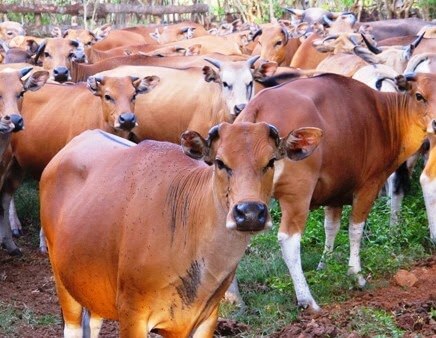
By: Dr. Yayuk Kholifah
Position: (First Veterinary Medic)
Case of uterine prolapse is the condition where part or the entire uterus is expelled as a common complication that occurs during the third stage of labor (after the successful delivery of the fetus). This case is more common in cattle and sheep. In ruminants, prolapse cases often result in the complete expulsion of the cornua, whereas in pigs and dogs, the organ's expulsion usually involves only part of the uterus or one cornu.
Cows that have previously given birth have a higher risk of experiencing uterine prolapse compared to heifers. In most cases, uterine prolapse occurs a few hours after giving birth, but it can also occur several days after birth.
The exact causes of uterine prolapse are not yet clear, but it can be said that cases often occur during the third stage of the birthing process, a few hours after the expulsion of the fetus and after several cotyledons of the fetus detach from the maternal caruncle. The only force that can lift the heavy uterus from the cow's abdomen and expel it from the body is abdominal straining. Abdominal straining in the process of calving is normal. Abdominal straining is also synchronized with peristaltic contractions of the uterus, occurring every 3.5 to 4 minutes. The force of straining, combined with supporting factors, is suspected as the cause of uterine prolapse. The gravitational force present in overly sloped barn conditions and the pressure from other organs around the uterus, such as the urinary-filled bladder combined with residual uterine fluid after birth, become factors that increase the risk of uterus expulsion from the abdominal cavity.
The prognosis of a prolapse case highly depends on the case type, whether the uterus experienced severe damage outside the body and how long the uterus remained outside before receiving treatment. However, if promptly managed by professionals immediately after occurrence, the prognosis is favorable. Uterine prolapse cases can also lead to death due to internal bleeding from ruptured arterial blood vessels pulled out with the expulsion of the uterus. Moreover, the organ can also become infected and the endometrium of the animal hardens.
Repositioning the organ to its original position is essential for animals experiencing prolapse. Ensure you promptly seek medical assistance to reposition the uterus. However, before receiving medical attention, farmers should perform some emergency aid steps. If prolapse occurs in recumbent animals and cows, farmers should wrap the protruding organ with clean cloth to prevent contamination. However, if the cow is standing, the protruding organ should be supported with a cloth to prevent internal bleeding due to the rupture of arteries inside the body.
The expelled uterus should be thoroughly rinsed with warm normal saline solution to prevent dryness and damage. If part of the fetal membrane has detached, the professionals usually remove the entire membrane before repositioning the uterus. If the membrane has not detached and there's a possibility of bleeding upon removal, the uterus will be inserted directly without first removing the membrane one by one. Animals can also be given anesthesia to reduce straining and antibiotics to prevent infection after treatment. Animals that have had their organs repositioned should have their hindquarters elevated to prevent a recurrence of prolapse cases.
Sources:
Noakes D.E, Parkinson T.J, England G.C.W; 2001; “Arthur’s Veterinary Reproduction and Obstetrics Eighth Edition”; Elsevier Limited; ISBN: 978 0 7020 2556 3



